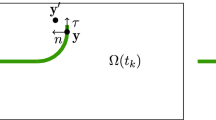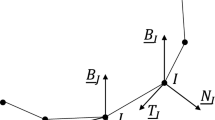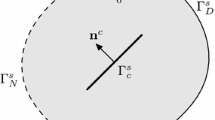Abstract
This paper proposes a three-dimensional meshfree method for arbitrary crack initiation and propagation that ensures crack path continuity for non-linear material models and cohesive laws. The method is based on a local partition of unity. An extrinsic enrichment of the meshfree shape functions is used with discontinuous and near-front branch functions to close the crack front and improve accuracy. The crack is hereby modeled as a jump in the displacement field. The initiation and propagation of a crack is determined by the loss of hyperbolicity or the loss of material stability criterion. The method is applied to several static, quasi-static and dynamic crack problems. The numerical results very precisely replicate available experimental and analytical results.
Similar content being viewed by others

References
Alonso A, Valli A (1997) A domain decomposition approach for heterogenous time-harmonic maxwell equations. Comput Methods Appl Mech Eng 143:97–112
Alonso A, Valli A (1999) An optimal domain decomposition preconditioner for low-frequency maxwell equations. Math Comput 68:607–631
Areias PMA, Belytschko T (2005) Analysis of three-dimensional crack initiation and propagation using the extended finite element method. Int J Numer Methods Eng 63:760–788
Arrea M, Ingraffea AR (1982) Mixed-mode crack propagation in mortar and concrete. Technical Report 81-13, Department of Structural Engineering Cornell University Ithaka
Beck R, Hiptmair R, Hoppe RHW, Wohlmuth B (2000) Residual based a posteriori error estimators for eddy current computation. Math Model Numer Anal 34:159–182
Bellec J, Dolbow JE (2003) A note on enrichment functions for modelling crack nucleation. Commun Numer Methods Eng 19:921–932
Belytschko T, Chen H, Xu J, Zi G (2003) Dynamic crack propagation based on loss of hyperbolicity and a new discontinuous enrichment. Int J Numer Methods Eng 58(12):1873–1905
Belytschko T, Lu YY, Gu L (1994) Element-free Galerkin methods. Int J Numer Methods Eng 37:229–256
Belytschko T, Moes N, Usui S, Parimi C (2001) Arbitrary discontinuities in finite elements. Int J Numer Methods Eng 50(4):993–1013
Bordas S (2003) Extended finite element and level set methods with applications to growth of cracks and biofilms. PhD Thesis, Northwestern University
Bordas S, Moran B (2006) Extended finite element and level set method for damage tolerance assessment of complex structures: an object-oriented approach. EFM (in press)
Bordas S, Legay A (2005) Enriched finite element short course: class notes. In: The extended finite element method, a new approach to numerical analysis in mechanics: course notes. Organized by S. Bordas and A. Legay through the EPFL school of continuing education, Lausanne, Switzerland
Cervenka J (1994) Discrete crack modeling in concrete structures. PhD Thesis, University of Colorado
Chevrier P, Klepaczko JR (1999) Spall fracture: Mechanical and microstructural aspects. Eng Fract Mech 63:273–294
Chopp DL, Sukumar N (2003) Fatigue crack propagation of multiple coplanar cracks with the coupled extended finite element/fast marching method. Int J Eng Sci 41:845–869
Daux C, Moes N, Dolbow J, Sukumar N, Belytschko T (2000) Arbitrary branched and intersection cracks with the extended finite element method. Int J Numer Methods Eng 48:1731–1760
Demkovicz L, Vardapetyan L (1998) Modeling of electromagnetic absorption/scattering problems using hp-adaptive finite elements. Comput Methods Appl Mech Eng 152:103–124
Devloo P, Oden TJ, Pattani P (1988) An h-p adaptive finite element method for the numerical simulation of compressible flow. Comput Methods Appl Mech Eng 70(2):203–235
Duflot M (2006) A meshless method with enriched weight functions for three-dimensional crack propagation. Int J Numer Methods Eng 65(12):1970–2006
Galdos R (1997) A finite element technique to simulate the stable shape evolution of planar cracks with an application to a semi-elliptical surface crack in a bimaterial finite solid. Int J Numer Methods Eng 40:905–917
Gasser TC, Holzapfel GA (2005) Modeling 3D crack propagation in unreinforced concrete using PUFEM. Comput Methods Appl Mech Eng 194:2859–2896
Gravouil A, Moes N, Belytschko T (2002) Non-planar 3D crack growth by the extended finite element and level sets—Part II: Level set update. Int J Numer Methods Eng 53:2569–2586
Hiptmair R (1998) Multigrid method for maxwell’s equations. SIAM J Numer Anal 36:204–225
Houston P, Perugia H, Schötzau D (2005) Energy norm a posteriori error estimation for mixed discontinuous galerkin approximations of the maxwell operator. Comput Methods Appl Mech Eng 194:499–510
Johnson GR, Cook WH (1983) A constitutive model and data for metals subjected to large strains, high strain rates, and high temperatures. In: Proceedings of 7th International Symposium on Ballistics
Kalthoff JF, Winkler S (1987) Failure mode transition at high rates of shear loading. Int Conf Impact Load Dyn Behav Mater 1:185–195
Krysl P, Belytschko T (1999) The element free Galerkin method for dynamic propagation of arbitrary 3-D cracks. Int J Numer Methods Eng 44(6):767–800
Lemaitre J (1971) Evaluation of dissipation and damage in metal submitted to dynamic loading. In: Proceedings ICM 1
Li S, Simonson Bo C (2004) Meshfree simulation of ductile crack propagation. Int J Comput Methods Eng Sci Mech 6:1–19
Liu WK, Jun S, Li S, Adee J, Belytschko T (1995) Reproducing kernel particle method for structural dynamics. Int J Numer Methods Eng 38:1665–1679
Liu WK, Li S, Belytschko T (1997) Moving least square reproducing kernel method. (I) methodology and convergence. Comput Methods Appl Mech Eng 143:113–154
Liu Y, Murakami S, Kanagawa Y (1994) Mesh-dependence and stress singularity in finite element analysis of creep crack growth by continuum damage mechanics approach. Eur J Mech A/Solids 13:395–417
Lo SH, Dong CY, Cheung YK (2005) Integral equation approach for 3d multiple crack problems. Eng Fract Mech 72:1830–1840
Loehner R (2001) Applied CFD techniques: an introduction based on finite element methods. Wiley, New York
Martha LF, Wawrzynek PA, Ingraffea AR (1993) Arbitrary crack representation using solid modeling. Eng Comput 9:63–82
Moes N, Dolbow J, Belytschko T (1999) A finite element method for crack growth without remeshing. Int J Numer Methods Eng 46(1):133–150
Moes N, Gravouil A, Belytschko T (2002) Non-planar 3-D crack growth by the extended finite element method and level sets, Part I: Mechanical model. Int J Numer Methods Eng 53(11):2549–2568
Monk P (1994) On the p- and hp-extension of nedelec’s curl-conforming elements. J Comput Appl Math 53:117–137
Monk P (1998) A posteriori error indicators for maxwell’s equations. J Comput Appl Math 100:173–190
Ogden RW (1984) Non-linear elastic deformations. Halsted, New York
Oliver J, Huespe AE, Snchez PJ (2006) A comparative study on finite elements for capturing strong discontinuities: E-fem vs. x-fem. Comput Methods Appl Mech Eng (in press)
Rabczuk T, Areias PMA, Belytschko T (2006) A simplified meshfree method for shear bands with cohesive surfaces. Int J Numer Methods Eng (submitted)
Rabczuk T, Belytschko T (2005) Adaptivity for structured meshfree particle methods in 2D and 3D. Int J Numer Methods Eng 63(11):1559–1582
Rabczuk T, Belytschko T, Xiao SP (2004) Stable particle methods based on lagrangian kernels. Comput Methods Appl Mech Eng 193:1035–1063
Rachowicz W, Demkovicz L (2000) An hp-adaptive finite element method for electromagnetics—Part I: Data structure and constrained approximation. Comput Methods Appl Mech Eng 187:307–335
Rachowicz W, Demkovicz L (2002) An hp-adaptive finite element method for electromagnetics-part ii: a 3d implementation. Int J Numer Methods Eng 53:147–180
Simkins DC Jr, Li S (2006) Meshfree simulations of ductile failure under thermal-mechanical loads. Comput Mech 3:235–249
Sukumar N, Moran B, Black T, Belytschko T (1997) An element-free Galerkin method for three-dimensional fracture mechanics. Comput Mech 20:170–175
Teng X, Wierzbicki T, Hiermaier S, Rohr I (2005) Numerical prediction of fracture in the Taylor test. Int J Solids Struct 42:1919–1948
Vardapetyan L, Demkovicz L (1999) hp-adaptive finite elements in electromagnetics. Comput Methods Appl Mech Eng 169:331–344
Ventura G, Xu J, Belytschko T (2002) A vector level set method and new discontinuity approximations for crack growth by EFG. Int J Numer Methods Eng 54(6):923–944
Xu G, Bower FP, Ortiz M (1994) An analysis of non-planar crack growth under mixed mode loading. Int J Solids Struct 31:2167–2193
Xu G, Ortiz M (1993) A variational boundary integral method for the analysis of 3D cracks of arbitrary geometry modelled as continuous distributions of dislocation loops. Int J Numer Methods Eng 36:3675–3701
Xu X-P, Needleman A (1994) Numerical simulations of fast crack growth in brittle solids. J Mech Phys Solids 42:1397–1434
Zi G, Song J-H, Budyn E, Lee S-H, Belytschko T (2004) A method for growing multiple cracks without remeshing and its application to fatigue crack growth. Model Simul Mater Sci Eng 12(1):901–915
Zienkiewicz OC, Zhu JZ (1992) The superconvergent patch recovery and a posteriori error estimates. Part I: The recovery technique. Int J Numer Methods Eng 33:1331–1364
Author information
Authors and Affiliations
Corresponding author
Rights and permissions
About this article
Cite this article
Rabczuk, T., Bordas, S. & Zi, G. A three-dimensional meshfree method for continuous multiple-crack initiation, propagation and junction in statics and dynamics. Comput Mech 40, 473–495 (2007). https://doi.org/10.1007/s00466-006-0122-1
Received:
Accepted:
Published:
Issue Date:
DOI: https://doi.org/10.1007/s00466-006-0122-1



